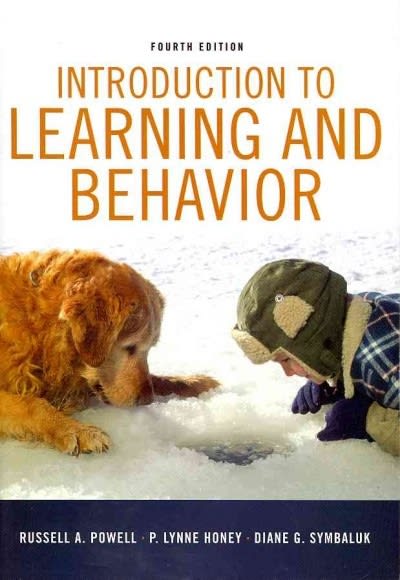
Introduction to Learning and Behavior 4th Edition by Marcia Darvin Spada, Russell Powell, Lynne Honey,Diane Symbaluk
Edition 4ISBN: 978-1285401447
Introduction to Learning and Behavior 4th Edition by Marcia Darvin Spada, Russell Powell, Lynne Honey,Diane Symbaluk
Edition 4ISBN: 978-1285401447 Exercise 2
In _______ conditioning, behaviors that the average person typically regards as (voluntary/involuntary) come to be elicited in new situations.
Explanation
Learning can be defined as a relatively permanent change in the behavior, which is a result of some kind of experience. Any change in behavior is however, not necessary to be immediate in nature.
In certain circumstances, this change in behavior might not even become evident until a long time passes after the experience. There are two basic processes of learning namely classical (also called as pavlovian or respondent) and operant conditioning.
Classical conditioning is the process whereby certain behaviors, which are inborn or innate, come to be produced or elicited in situations, which are new. These are behaviors, which the average person considers as involuntary or reflexive in nature.
Examples can be seen in case of sneezing due to dust or even pollen grains (as is the case of certain allergies). Another example is salivation caused as a response to food. This is a classical example seen in most psychology textbooks where a dog is taught to salivate in response to a bell, which is associated with his or her food.
So, blank (a) can be filled with and blank (b) can be filled with
and blank (b) can be filled with  .
.
In certain circumstances, this change in behavior might not even become evident until a long time passes after the experience. There are two basic processes of learning namely classical (also called as pavlovian or respondent) and operant conditioning.
Classical conditioning is the process whereby certain behaviors, which are inborn or innate, come to be produced or elicited in situations, which are new. These are behaviors, which the average person considers as involuntary or reflexive in nature.
Examples can be seen in case of sneezing due to dust or even pollen grains (as is the case of certain allergies). Another example is salivation caused as a response to food. This is a classical example seen in most psychology textbooks where a dog is taught to salivate in response to a bell, which is associated with his or her food.
So, blank (a) can be filled with
 and blank (b) can be filled with
and blank (b) can be filled with  .
.Introduction to Learning and Behavior 4th Edition by Marcia Darvin Spada, Russell Powell, Lynne Honey,Diane Symbaluk
Why don’t you like this exercise?
Other Minimum 8 character and maximum 255 character
Character 255


